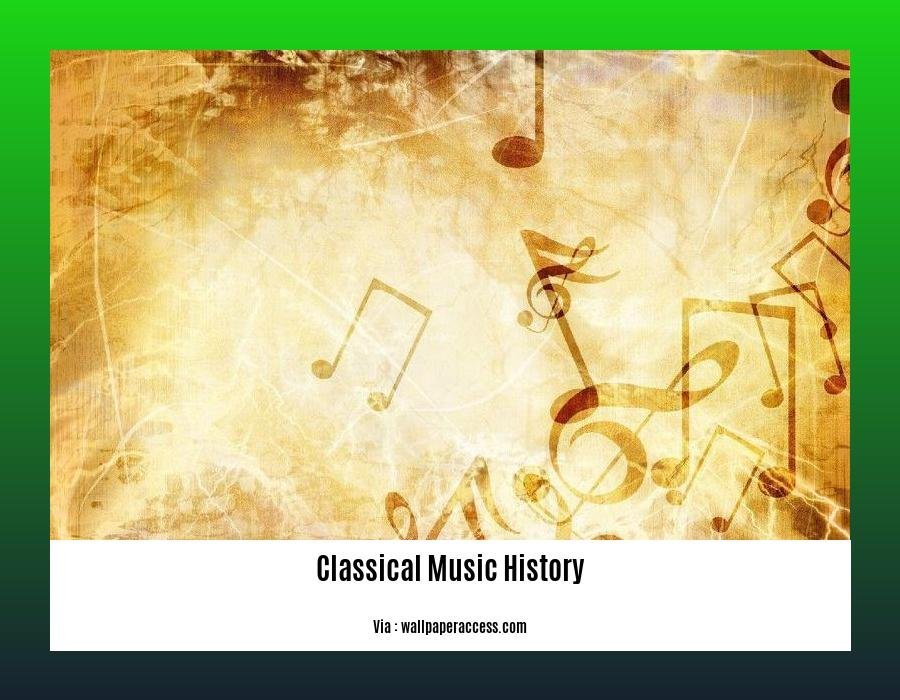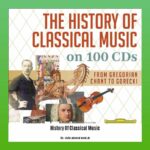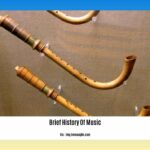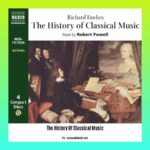Step into the grand concert halls of history and embark on an enthralling journey through classical music’s rich tapestry. From the origins of Gregorian chant to the virtuosity of the Romantic era, “Unveiling the Masterpieces: A Journey Through Classical Music History” paints a vivid portrait of the evolution of musical forms and the lives of the geniuses who shaped them. Discover the stories behind iconic compositions, the innovations that transformed instruments, and the cultural forces that influenced the classical music landscape. Prepare to be mesmerized as we unravel the secrets of classical masterpieces and trace the fascinating paths that led to their creation.
Key Takeaways:
-
Classical music is the art music of the Western world, known for its formality, complexity, and harmonic organization.
-
The tradition begins in the 9th century with music created for the early Christian Church.
-
It’s primarily a written tradition, using a sophisticated notation system and analytical literature.
-
Composers’ compositions, personalities, and beliefs have shaped the history of classical music.
-
Early medieval music was religious, monophonic, and vocal, influenced by ancient Greek and Roman music.
-
Surviving early medieval music is primarily religious in nature.
Classical Music History: A Journey Through Sound
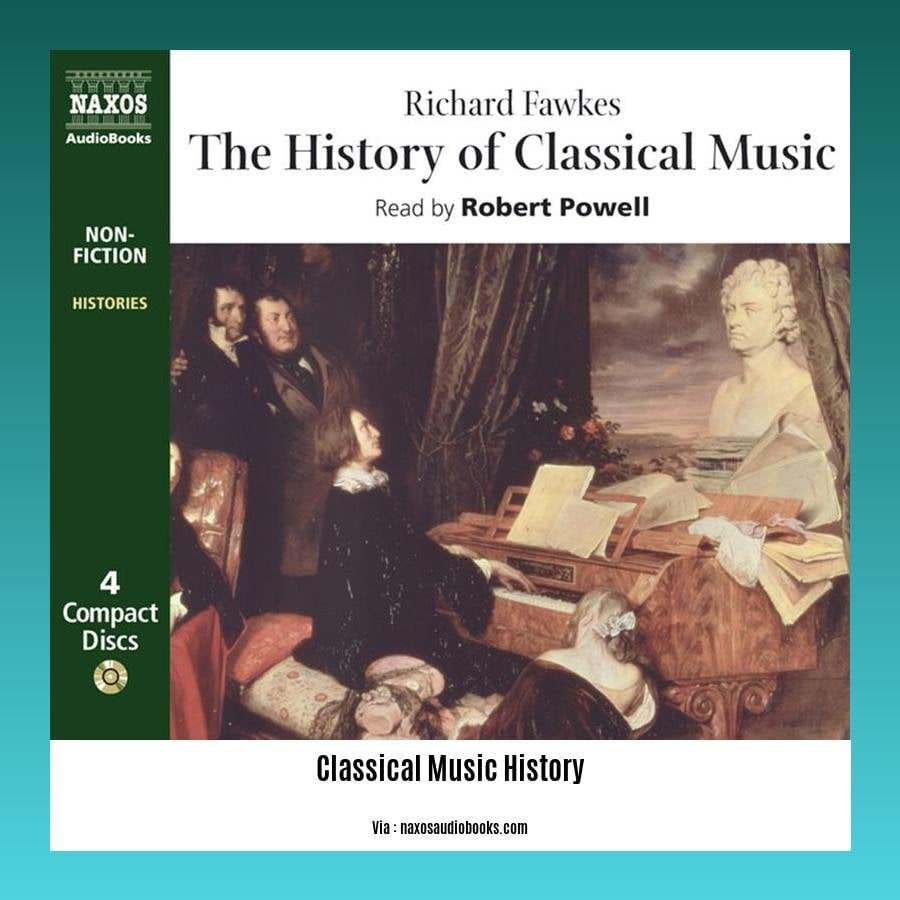
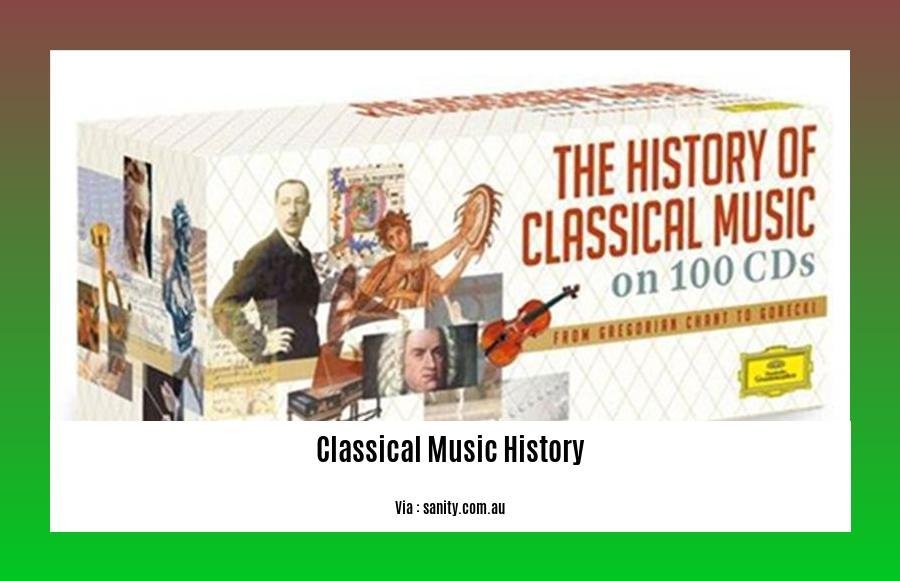
Throughout history, classical music has showcased mankind’s creative genius. From the serene hymns of early medieval times to the complex compositions of the Romantic era, the classical music journey is a captivating saga. Let’s delve into the evolution of this art form and experience its transformative power.
The Evolving Landscape of Classical Music History
- Medieval Era (500-1400 AD):
- Monophonic chants and religious works dominated this period.
-
Gregorian chant, a cornerstone of medieval music, showcased the power of sacred melodies.
-
Renaissance Era (1400-1600 AD):
- Polyphony, with multiple melodies interwoven, emerged as a defining characteristic.
-
Composers like Palestrina and Lassus crafted intricate vocal works that showcased their mastery of counterpoint.
-
Baroque Era (1600-1750 AD):
- The rise of instrumental music, including concertos and sonatas.
-
Johann Sebastian Bach, a towering figure, left an indelible mark with his intricate fugues and cantatas.
-
Classical Era (1750-1820 AD):
- A focus on balance, clarity, and proportion characterized this era.
-
Composers like Mozart and Haydn created graceful symphonies and elegant concertos that exemplified the classical style.
-
Romantic Era (1820-1900 AD):
- Emotions, individualism, and dramatic expression took center stage.
- Beethoven, a revolutionary, challenged conventions with his passionate symphonies and sonatas.
- Romantic composers like Tchaikovsky and Brahms explored the depths of human experience through their music.
Exploring the Masterpieces of Classical Music History
- Bach’s “Brandenburg Concertos”:
-
A set of six concertos showcasing Bach’s genius in blending multiple instruments and creating intricate contrapuntal textures.
-
Beethoven’s “Symphony No. 9”:
-
A monumental work featuring a choral finale with Schiller’s “Ode to Joy,” representing the triumph of the human spirit.
-
Mozart’s “The Marriage of Figaro”:
-
A beloved opera that combines beautiful melodies, witty dialogue, and a captivating storyline, showcasing Mozart’s mastery of the genre.
-
Tchaikovsky’s “Swan Lake”:
- A captivating ballet score that evokes a world of enchantment and tragedy, characterized by its sweeping melodies and lush orchestration.
Classical Music’s Enduring Legacy
Classical music has stood the test of time, captivating audiences across generations. Its ability to express the human experience, evoke emotions, and transport listeners to different worlds makes it a timeless art form.
Whether you’re a seasoned aficionado or a newcomer to this enchanting world, the classical music journey offers something for everyone. So, let the melodies of the past resonate in your soul and immerse yourself in the rich tapestry of classical music history.
Thought-Provoking Questions:
-
Imagine a world without classical music. What would our cultural landscape look like?
-
Which era of classical music resonates with you the most? Why do you think that is?
-
What challenges do you think contemporary classical music composers face in creating works that are both innovative and true to tradition?
**Classical Period Instruments: A Symphony of Innovation**
Innovation flourished in the classical period (1750-1820), giving birth to a diverse array of instruments that forever shaped the landscape of classical music. In this era of exploration, composers sought to expand their sonic palette, pushing the boundaries of musical expression. Let’s embark on a journey to discover the masterpieces of this period and the instrumental marvels that brought them to life.
Key Takeaways:
- Innovations in Classical period instruments laid the foundation for the modern orchestra.
- The addition of woodwinds and brass instruments expanded the range and expressiveness of orchestration.
- String instruments, such as the violin, viola, and cello, continued to refine their design and techniques.
- Keyboard instruments, like the harpsichord and fortepiano, evolved to meet the demands of classical music’s intricate compositions.
- Smaller percussion instruments, such as the tambourine, triangle, and bells, added delicate accents and rhythmic drive.
Orchestral Expansion:
- Woodwind instruments, including the flute, oboe, clarinet, and bassoon, gained prominence, providing new colors and textures to the orchestra.
- Brass instruments like the trumpet, horn, and trombone added depth and brilliance, enhancing the power and majesty of the ensemble.
String Innovations:
- String instruments, the backbone of the orchestra, underwent modifications to improve their resonance and playability.
- The violin’s design was refined, resulting in a more focused and brilliant tone.
- The viola and cello received adjustments to enhance their lower registers, adding warmth and richness to the ensemble.
Keyboard Evolution:
- Keyboard instruments played a crucial role in classical music, providing harmonic support and soloistic brilliance.
- The harpsichord remained popular, with its bright, plucked sound adding clarity and rhythmic precision.
- The fortepiano, a precursor to the modern piano, emerged as a versatile instrument capable of expressing a wide range of dynamics and emotions.
Percussive Accents:
- Smaller percussion instruments, such as the tambourine, triangle, and bells, added delicate accents and rhythmic drive to orchestral compositions.
- Drums, including the timpani and snare drum, provided a solid foundation and dramatic punctuation.
**Citations:**
FAQ
Q1: What are the origins of classical music?
A1: Classical music, with its roots in the early Christian Church, traces its beginnings to the 9th century. Initially characterized by religious, monophonic, and vocal music, it was influenced by ancient Greek and Roman musical traditions.
Q2: Who are some of the renowned composers associated with classical music?
A2: Classical music is adorned with the contributions of numerous celebrated composers whose compositions, personalities, and beliefs have shaped its history. This includes influential figures like J.S. Bach, Wolfgang Amadeus Mozart, Ludwig van Beethoven, Frédéric Chopin, and many more.
Q3: What instruments were commonly used during the classical period?
A3: The classical period (1750-1820) witnessed significant advancements in instrumentation. Notable instruments included early brass instruments like the slide trumpet and valveless trumpet, adapted string instruments like the viol and lute, keyboard instruments like the harpsichord, small percussion instruments, and early woodwind instruments like the transverse flute and recorder.
Q4: What are some of the characteristics of classical music?
A4: Classical music is distinguished by its formality, showcasing complexity in musical form and harmonic organization. It has been primarily a written tradition, utilizing a sophisticated notational system and accompanied by analytical, critical, and historiographical literature.
Q5: What are some of the key events that shaped the evolution of classical music?
A5: The evolution of classical music has been marked by several pivotal events. The transition from monophonic to polyphonic music, the development of new musical forms such as the sonata and symphony, and the rise of opera as a significant genre are among the notable milestones that shaped its history.
- Unraveling Einstein’s Legacy: Who Inherited His Genius? - July 14, 2025
- Unlock Einstein’s Family Tree: Bernhard Caesar & Untold Stories - July 14, 2025
- Unveiling Bernhard Caesar Einstein: His Life & Albert Einstein’s Legacy - July 14, 2025
